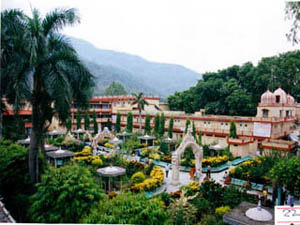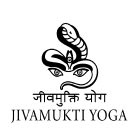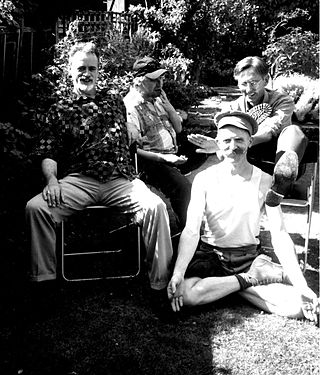
An ashram is a spiritual hermitage or a monastery in Indian religions.

Siddha Yoga is a spiritual path founded by Swami Muktananda (1908–1982). According to its literature, the Siddha Yoga tradition is "based mainly on eastern philosophies" and "draws many of its teachings from the Indian yogic texts of Vedanta and Kashmir Shaivism, the Bhagavad Gita and the poet-saints." The present head of Siddha Yoga is Gurumayi Chidvilasananda.
The Mysore style of asana practice is the way of teaching yoga as exercise within the Ashtanga Vinyasa Yoga tradition as taught by K. Pattabhi Jois in the southern Indian city of Mysore; its fame has made that city a yoga hub with a substantial yoga tourism business.
Gurumayi Chidvilasananda, born Malti Shetty on 24 June 1955, is the guru or spiritual head of the Siddha Yoga path, with ashrams in India at Ganeshpuri and the Western world, with the headquarters of the SYDA foundation in Fallsburg, New York.

Rishikesh, also spelt as Hrishikesh, is a city near Dehradun in Dehradun district of the Indian state Uttarakhand. It is situated on the right bank of the Ganges River and is a pilgrimage town for Hindus, with ancient sages and saints meditating here in search of higher knowledge. There are numerous temples and ashrams built along the banks of the river.

Muni Ki Reti is a town and a municipal council in Tehri Garhwal district in the Indian state of Uttarakhand. It lies close to the pilgrimage town of Rishikesh and is known for its ashrams, including the Divine Life Society of Sivananda Saraswati.
Gurudev Siddha Peeth is an Indian ashram run by the Gurudev Siddha Peeth Trust and serving the Siddha Yoga path. It is situated between the villages of Ganeshpuri and Vajreshwari in the state of Maharashtra, 70 miles (110 km) north-east of Mumbai. On the Siddha Yoga path it is known as the "mother ashram" because it is where Siddha Yoga began.
In February 1968, the English rock band the Beatles travelled to Rishikesh in northern India to take part in a Transcendental Meditation (TM) training course at the ashram of Maharishi Mahesh Yogi. The visit followed the group's denunciation of drugs in favour of TM and received widespread media attention. The band's interest in the Maharishi's teachings was led by George Harrison's commitment, and it changed Western attitudes about Indian spirituality and encouraged the study of Transcendental Meditation. The visit was also the most productive period for the Beatles' songwriting.

Parmarth Niketan is an ashram located in Rishikesh, Uttarakhand, India.

The Jivamukti Yoga method is a proprietary style of yoga created by David Life and Sharon Gannon in 1984.

André Van Lysebeth was a Belgian yoga instructor and author whose books about yoga have been translated into many languages. He is also known for a quintessential book on human sexuality he took thirty years of his life to write, Tantra: The Cult of the Feminine.
Religious tourism in India is a focus of Narendra Modi's national tourism policy. Uttarakhand has been popular as a religious and adventure tourism hub.
Beatles Ashram, also known as Chaurasi Kutia, is an ashram close to the north Indian city of Rishikesh in the state of Uttarakhand. It is located on the eastern bank of the Ganges river, opposite the Muni Ki Reti area of Rishikesh, in the foothills of the Himalayas. During the 1960s and 1970s, as the International Academy of Meditation, it was the training centre for students of Maharishi Mahesh Yogi, who devised the Transcendental Meditation technique. The ashram gained international attention between February and April 1968 when the English rock band the Beatles studied meditation there, along with celebrities such as Donovan, Mia Farrow and Mike Love. It was the setting for the band's most productive period as songwriters, where they composed most of the songs for their self-titled double album, also known as the "White Album".

Yoga as exercise is a physical activity consisting mainly of postures, often connected by flowing sequences, sometimes accompanied by breathing exercises, and frequently ending with relaxation lying down or meditation. Yoga in this form has become familiar across the world, especially in the US and Europe. It is derived from medieval Haṭha yoga, which made use of similar postures, but it is generally simply called "yoga". Academics have given yoga as exercise a variety of names, including modern postural yoga and transnational anglophone yoga.
Anne Cushman is an American teacher of yoga as exercise and meditation, a writer on Mindful Yoga, and a novelist. Her novel Enlightenment for Idiots was named by Booklist as one of the top ten novels of 2008. Cushman has also been an editor for Yoga Journal and Tricycle: The Buddhist Review. She directs mentoring programs and multi-year meditation training for yoga teachers at the Spirit Rock Meditation Center, emphasizing the fusion of yoga and Buddhist meditation and highlighting their shared history and philosophy.
Yoga teacher training is the training of teachers of yoga as exercise, consisting mainly of the practice of yoga asanas, leading to certification. Such training is accredited by the Yoga Alliance in America, by the British Wheel of Yoga in the United Kingdom, and by the European Union of Yoga across Europe. The Yoga Alliance sets standards for 200-hour and 500-hour Recognized Yoga Teacher levels, which are accepted in America and other countries.

Yoga in Britain is the practice of yoga, including modern yoga as exercise, in Britain. Yoga, consisting mainly of postures (asanas), arrived in Britain early in the 20th century, though the first classes that contained asanas were described as exercise systems for women rather than yoga. Classes called yoga, again mainly for women, began in the 1960s. Yoga grew further with the help of television programmes and the arrival of major brands including Iyengar Yoga and Ashtanga Vinyasa Yoga.

Postural yoga began in India as a variant of traditional yoga, which was a mainly meditational practice; it has spread across the world and returned to the Indian subcontinent in different forms. The ancient Yoga Sutras of Patanjali mention yoga postures, asanas, only briefly, as meditation seats. Medieval Haṭha yoga made use of a small number of asanas alongside other techniques such as pranayama, shatkarmas, and mudras, but it was despised and almost extinct by the start of the 20th century. At that time, the revival of postural yoga was at first driven by Indian nationalism. Advocates such as Yogendra and Kuvalayananda made yoga acceptable in the 1920s, treating it as a medical subject. From the 1930s, the "father of modern yoga" Krishnamacharya developed a vigorous postural yoga, influenced by gymnastics, with transitions (vinyasas) that allowed one pose to flow into the next.

Modern yoga gurus are people widely acknowledged to be gurus of modern yoga in any of its forms, whether religious or not. The role implies being well-known and having a large following; in contrast to the old guru-shishya tradition, the modern guru-follower relationship is not secretive, not exclusive, and does not necessarily involve a tradition. Many such gurus, but not all, teach a form of yoga as exercise; others teach forms which are more devotional or meditational; many teach a combination. Some have been affected by scandals of various kinds.

Siddeshwar Swami was an Indian Hindu saint and spiritual leader known for his teachings on yoga and spirituality. Swami was the head of Jnanayogashrama, an ashram in the city of Vijayapura, in the Indian state of Karnataka. He declined the Padma Shri, India's fourth-highest civilian award, when it was awarded to him in 2018. He had earlier declined an honorary doctorate from the Karnatak University.















